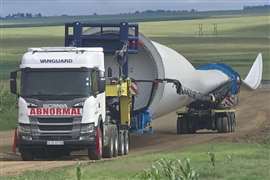Read this article in French German Italian Portuguese Spanish
First look: 100 metre jib flat top tower
07 December 2023
A new tower crane with 100 metre jib was the unusual sight greeting visitors to AMS Kranbau in Germany recently. Heinz-Gert Kessel reports.
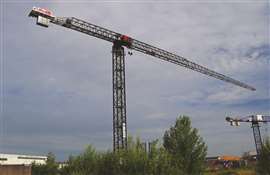 The AMS giant AK810 with 100 metre jib on the test pad at the factory in Germany.
The AMS giant AK810 with 100 metre jib on the test pad at the factory in Germany.
Tower crane manufacturer AMS Kranbau in Germany has unveiled a new flat top with a 100 metre jib.
A tower crane with a 100 metre jib is a rare thing. Even conventional saddle jib construction tower cranes have jibs with a maximum length of 80 or 90 metres. These cranes follow standard hammerhead design with a high tower head and a number of stays supporting the long jib.
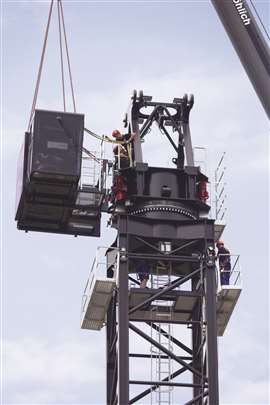 Enlarged cabin unit with enclosed electric cabinet in the colours of the first customer. Access to the spacious cabin is provided by a platform which can be used for emergency treatment of the driver.
Enlarged cabin unit with enclosed electric cabinet in the colours of the first customer. Access to the spacious cabin is provided by a platform which can be used for emergency treatment of the driver.
A rare exception is the custom-designed Wolff 8540 with 100 metre jib instead of the standard 85 metre version. As a member of the XXL series introduced in 2000 the 8540 offered a capacity of 2.7 tonnes at 100 metres radius. Generally, you would expect a better tip load from a hammerhead crane design with high cat top and pendant lines supporting the jib, over a flat top design.
Several factors affect this, however, including the restricted site conditions of today’s construction sites. In Germany, the exponentially rising government permit costs for mobilisation of large wheeled mobile cranes to install large tower cranes is another major issue. A new tower crane design philosophy is needed.
In addition, there is a growing market for long jib versions with reasonable tip capacity. Increasingly, the only space to install a crane is a long way from where it has to reach. Examples include big bridge projects and industrial constructions like data centres.
Such applications call for a smart flat top crane design which overcomes the design-integrated transport disadvantage of the high-profile jib sections on large flat top towers. An even better tip load capacity than long jib versions of existing conventional hammerhead cranes is also needed.
Drawing on experience
In designing the new crane AMS engineers drew on experience gained from the company’s fabrication of the well-known BKT line of large flat top cranes. An example is the BKT 412 from 1998 with 75 metre jib and 3 tonne tip capacity. AMS found a transport- and rigging-friendly solution for its all-new AK810 with 100 metre jib and tip load of 3.5 tonnes.
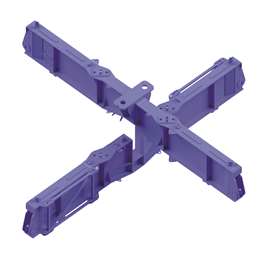 The crane base only made up of two beams for alternative 8 x 8 or 10 x 10 metre installation of the AK810.
The crane base only made up of two beams for alternative 8 x 8 or 10 x 10 metre installation of the AK810.
Two versions are offered. The heavy lift, 40 tonner on four falls of rope lifts its maximum load out to 28.4 metres radius and still lifts 31.5 tonnes at the end of the short (35 metre) jib. It is aimed at the rising market of PPVC module construction and conventional pre-cast construction work.
The prototype of the AK810 presented at a recent open day was designed to lift 20 tonnes on two falls of rope. In this case the lighter trolley allows a maximum tip load of 3.5 tonnes instead of 2.3 tonnes on the 40 tonne version at 100 metres radius.
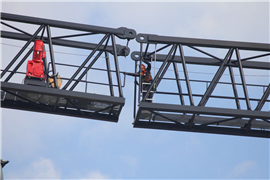 Fast jib section connection carried out by just one rigger.
Fast jib section connection carried out by just one rigger.
AMS managed to design the jib and counter jib sections in a way that allows transport on semi-trailers instead of expensive low beds. The counter jib sections can be laid over on their sides to keep the transport height within the essential 4 metre limit in central Europe.
To give the long boom sufficient rigidity its first three boom sections are square while the rest are triangular.
Moving and making
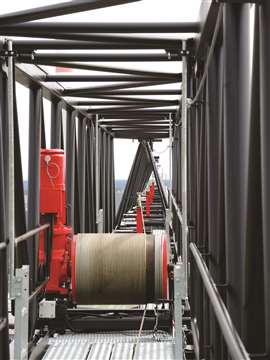 Look through the boom on the standing pulley supports for the saddle rope.
Look through the boom on the standing pulley supports for the saddle rope.
The slewing unit with a short A-frame make one transport and rigging unit weighing just 19.1 tonnes. This is the heaviest upper crane part for installation so a complete 100 metre jib crane on a 45 metre tower can be rigged using a 300 tonne capacity telescopic crane. The 100 metre boom is lifted in three sections, reducing load and the required space.
Its modular counter jib allows a choice of three lengths according to the requested jib length. For 35 to 45 metre jibs the short, 21.4 metre, counter jib is used. Up to a 65 metre jib the counter jib is extended to 25.4 metres. Longer jib combinations use a 29.4 metre counter jib.
Boom length can be altered in 5 metre increments. All boom and counter jib sections have slinging points. The upper part of the jib and counter jib sections are connected by sliding bolts, without needing a hammer. The lower chords automatically locate together just by lowering the jib section.
Final fixing is one longitudinal bolt on each side of the jib or counter jib section.
For easy reeving the rope is directed over standing pulley supports inside the jib. On a 2.6 x 2.6 metre tower system a 105 metre free standing height can be achieved.
Tower sections are available in 3, 6 and 12 metre lengths. Instead of slug pin tower section connection AMS prefers nuts and bolts.
Fast and easy installation is facilitated by making the cruciform base from two bolted beams. The outriggers have large screws to level the crane. The design allows the 105 metre free standing height and 100 metre jib configuration crane to be mounted in either an 8 x 8 metre or 10 x 10 metre space on the same base.
Operator space
The new crane’s cabin is designed to be spacious and has a large anti-glare front window to help with visibility. Its walk-in electrical cabinet is separated by a door inside the cabin.
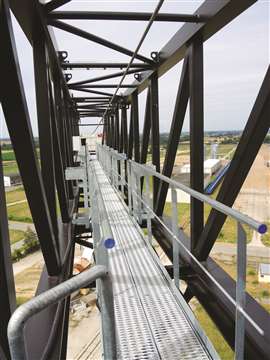 Safe walk through the counter jib. Note the handrail integrated platforms to reach the sliding bolts and the integrated lifting points for every counter jib section.
Safe walk through the counter jib. Note the handrail integrated platforms to reach the sliding bolts and the integrated lifting points for every counter jib section.
Operating parameters and other data can be viewed by the operator or sent to a remote office or smart phone.
AMS developed this remote-control system with the SKA Group alongside the smart work area limitation (WAL) system and the PLC software. It controls the four 7.5 kW slewing motors with frequency converters, plus the 90 kW hoist motor and 15 kW trolley motor.
For testing on the first crane SKA also provided a battery system to store energy gathered from lowering loads.
It is stored on the crane and can be used directly to reduce power consumption when lifting. It is expected to reduce the energy consumption of the crane by about 30 per cent.
Even though the crane was designed for a limited application it may also find a ready market worldwide.
This is due to the way it can be adapted to different site conditions in the 800 tonne-metre saddle jib crane class.
STAY CONNECTED


Receive the information you need when you need it through our world-leading magazines, newsletters and daily briefings.
CONNECT WITH THE TEAM










